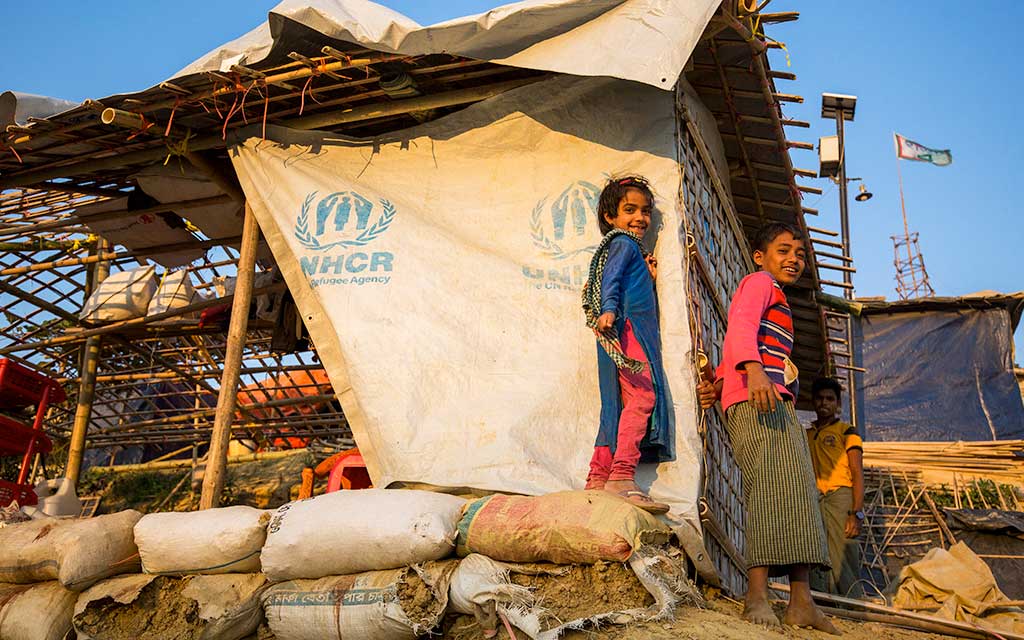‘Rohingya Refugee Crisis
Hajira and three-month-old Sadeka fled horrific violence in Myanmar during the Rohingya crisis.
Like so many other Rohingya families, they crossed the border into Bangladesh and now find themselves in the sprawling, overcrowded refugee camps near Cox’s Bazar.
Photo: ©UNHCR/Roger Arnold
Families like Hajira’s have been through so much.
Please help them to survive and rebuild their lives.

Shelter
including extra protection against monsoons

Clean water
to keep families safe from waterborne diseases

Essential items
like mattresses, blankets and kitchenware
The Rohingya Crisis Explained
The Rohingya crisis, which began in 1978 and severely escalated in August 2017, has driven nearly a million people from their homes in Myanmar. Violence and persecution, including the burning of entire Rohingya villages, forced over 750,000 Rohingya to flee to Bangladesh in August of 2017. At the peak of the crisis, thousands crossed into Bangladesh daily, walking for days through jungles and mountains or risking dangerous sea voyages. They arrived exhausted, hungry and sick, urgently needing protection and humanitarian assistance.
Cox’s Bazar, Bangladesh, now hosts the largest refugee camp in the world, housing over 965,000 Rohingya refugees. Living in overcrowded conditions, they rely heavily on humanitarian aid for essentials like food, water and healthcare. Monsoon seasons and events like Cyclone Mocha worsen their situation, increasing their vulnerability.
UNHCR, the UN Refugee Agency, provides critical support, including shelter, medical care, education and protection. Despite these efforts, the needs are immense, and resources are limited. The camps face ongoing challenges such as disease outbreaks, inadequate infrastructure and psychological trauma among refugees.
Efforts are being made to find long-term solutions, including the safe and voluntary return of the Rohingya to Myanmar. However, ongoing instability in Myanmar complicates this goal. The focus remains on improving living conditions, providing education and finding sustainable solutions for the Rohingya.
The Rohingya crisis highlights the severe impact of ethnic discrimination and violence, emphasizing the need for global support and attention. Continued international efforts are crucial to address the immediate needs and work towards a future where the Rohingya can live with dignity and security.
Who are the Rohingya?
The Rohingya are a stateless Muslim minority in Myanmar. Nearly a million Rohingya refugees have fled violence in successive waves of displacement since the early 1990s. The most recent mass migration began on 25 August 2017.
Violence broke out in Myanmar’s Rakhine State, forcing over 750,000 Rohingya to seek asylum in Bangladesh. . This situation is particularly detrimental to women and children, who constitute over 75 per cent of the refugee population and are more vulnerable to abuse and gender-based violence. Many others are elderly and require additional aid and protection.
How is UNHCR helping?
UNHCR, the UN Refugee Agency, and its partners are actively supporting the Government’s efforts to address the humanitarian and protection needs of Rohingya refugees. Entirely dependent on humanitarian aid, they require assistance with food, water, shelter, education and health. As Bangladesh faces climate change and natural disaster risks, UNHCR is emphasizing the necessity for disaster-resilient and environmentally conscious programming. To mitigate potential tensions between refugees and hosts, the organization is also addressing challenges impacting host communities, including environmental degradation and lack of health services.
UNHCR has been on the ground in Bangladesh leading the emergency response efforts by distributing urgently-needed supplies such as tents, blankets, sleeping mats and solar lamps. UNHCR has provided thousands of latrines and built water access for refugees. This has reduced the risk of spreading disease and improved overall sanitation.
UNHCR teams lead the protection response and are hard at work in all the refugee camps of Cox’s Bazar—providing life-saving essentials to families. We also support education and healthcare initiatives. UNHCR also helps refugees strengthen their shelters and prepare for the monsoon season, which falls between May and September, increasing the risk of floods and landslides.
We continue to identify the most vulnerable new arrivals, such as unaccompanied children, pregnant women, the elderly and the disabled. Our protection staff are working to establish child-friendly spaces and to prevent sexual and gender-based violence.
What are conditions like in the Rohingya refugee camps?
Throughout the Rohingya crisis, the camps have been vast, overcrowded and basic. Rohingya refugees have settled in and around Kutupalong and Nayapara refugee camps in Bangladesh’s Cox’s Bazar region, which have grown to become the largest and most densely populated camps in the world. Infrastructure and services there are stretched to their limits, with many families lacking adequate shelter, clean water and proper sanitation.
What are conditions like in the Rohingya refugee camps?
Throughout the Rohingya crisis, the camps have been vast, overcrowded and basic. Rohingya refugees have settled in and around Kutupalong and Nayapara refugee camps in Bangladesh’s Cox’s Bazar region, which have grown to become the largest and most densely populated camps in the world. Infrastructure and services there are stretched to their limits, with many families lacking adequate shelter, clean water and proper sanitation.
Where can I access the latest data and reports?
Bangladesh Operation—latest reports on UNHCR relief work in Bangladesh overall.
Myanmar Situation Portal —for latest updates on the crisis overall, including UNHCR situation reports and funding requirements.
Did you know that 16 million litres of clean water are needed every day to supply Rohingya refugee camps?

Tasmin and Monir escaped violence in Myanmar, but now face another threat—monsoons.
As the rainy season begins and waters rise, their shelter in Kutupalong refugee camp is at risk of flash flooding and landslides.
That’s why UNHCR is helping their family to build a new, reinforced shelter and protect themselves against the heaviest of rains.
Photo: ©UNHCR/Roger Arnold
Donate Today
Please help Rohingya refugee families in need.
Donate Today
Please help Rohingya refugee families in need.


